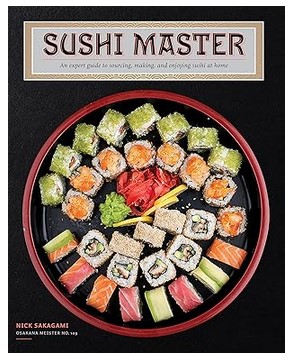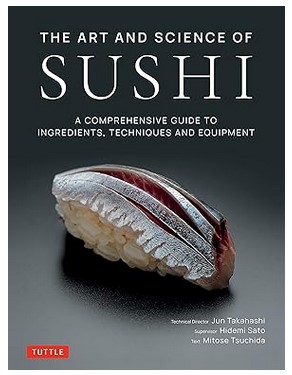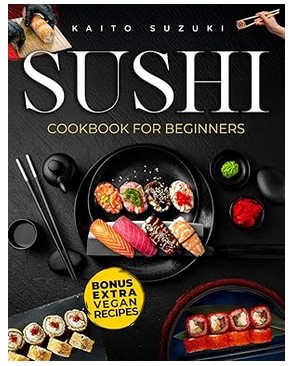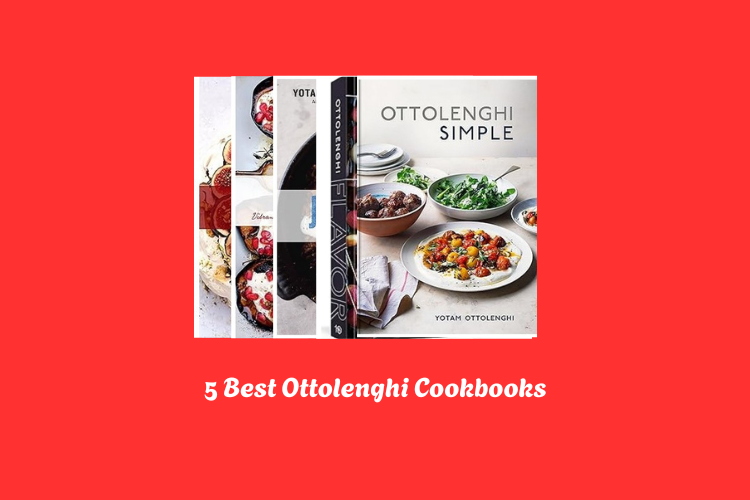5 Best Sushi Cookbooks to Elevate Your Home Dining
Sushi has moved beyond restaurant tables and into home kitchens, capturing the hearts of food lovers worldwide. The delicate balance of flavors, textures, and presentation makes sushi both an art and a culinary adventure.
Home chefs now explore techniques that were once reserved for professional sushi chefs, discovering the joy of rolling fresh sushi and experimenting with ingredients. A great sushi cookbook guides readers through essential skills, from selecting the perfect rice to mastering fish slicing techniques, while offering creative recipes that suit different tastes.
This guide highlights five exceptional sushi cookbooks that combine clear instructions, stunning visuals, and inspiring recipes. Each book helps enthusiasts expand their knowledge, refine their skills, and bring authentic Japanese flavors into everyday meals.
These cookbooks serve as trusted companions for beginners and seasoned cooks alike, making sushi preparation accessible, enjoyable, and rewarding at home.
5 Best Sushi Cookbooks 2025
1.
Cookbook Overview
Beginner-Friendly Instructions
This sushi cookbook focuses on beginners. Every recipe includes clear, step-by-step directions. Readers learn how to prepare sushi rice, handle fish safely, and roll sushi with ease. No prior experience is needed.
Variety of Recipes
The book features 100 recipes. Classic favorites like Tuna Rolls appear alongside unique options such as Spicy Fried Mozzarella Rolls. Recipes cover a wide range, making it easy to explore different flavors and textures.
Sushi Knowledge
Readers gain a solid understanding of sushi types, including sashimi, nigiri, and maki rolls. The guide explains essential sushi-making supplies like a rice paddle, rolling mat, and proper knives.
Recipe Categories
Classic Sushi Rolls
These recipes teach traditional options such as Tuna Rolls, Salmon Rolls, and California Rolls. They provide a foundation for learning authentic sushi techniques.
Vegetarian and Alternative Rolls
Vegetarian sushi recipes include avocado, cucumber, and pickled vegetables. Nontraditional rolls, like Spicy Fried Mozzarella Rolls, offer creative variations for adventurous eaters.
Sashimi and Nigiri
The cookbook introduces raw fish preparation for sashimi and hand-pressed nigiri. It explains fish selection, slicing techniques, and presentation tips.
Features
Essential Ingredients
Small pantry items, like roasted sesame seeds and dashi stock powder, make a big difference in taste. The guide shows how to combine simple ingredients for flavorful results.
Sushi-Making Tools
Readers learn about essential tools such as sushi-rolling mats, rice paddles, and sharp knives. Using the right equipment ensures better results and easier preparation.
Healthy Options
The recipes offer a balance of seafood and vegetarian options. They highlight fresh, healthy ingredients, making sushi a nutritious choice for any meal.
Step-by-Step Photos
Visual guidance helps beginners follow instructions accurately. Photos show each stage, from rice preparation to the final roll.
2.
Cookbook Overview
About the Authors
Two leading experts in North America created this book. They share decades of experience in sushi making. Their knowledge covers everything from ingredients and knives to plating and fish selection. Readers get professional tips in a way that is easy to follow.
Design and Presentation
The book is full color, with 500 photos and hundreds of tips. A concealed wiro-bound hardcover makes it user-friendly and durable. Photos show step-by-step techniques, making it easier to understand each process.
Learning Focus
This cookbook focuses on both sushi and sashimi. It explains the differences between Japanese and Western knives, along with the best substitutes. It also guides readers on equipment, rice preparation, and fish butchery.
Recipe Categories
Classic Sushi
Recipes include popular rolls like California and Dragon Rolls. These familiar favorites make a great starting point for beginners.
Nigiri and Sashimi
The book teaches traditional styles. Fluke (Hirame), Octopus (Tako), and Red Snapper (Tai) feature prominently. Techniques ensure the fish tastes fresh and delicate.
Specialty Rolls and Unique Ingredients
Tantalizing recipes include clam and sea urchin rolls. These options introduce cooks to a wider range of flavors and textures.
Plating and Presentation
Instructions show how to make sushi look beautiful. Presentation tips make meals more enjoyable and impressive.
Features
Step-by-Step Guidance
Every recipe has clear instructions. Beginners can follow along without confusion.
Knife Skills
Readers learn the importance of knives. Differences between Japanese and Western knives are explained, helping cooks choose the right tools.
Comprehensive Techniques
The book covers rice preparation, fish butchery, and plating. Hundreds of tips help improve skills gradually.
Visual Learning
500 full-color photos show every step. Seeing each technique makes learning easier and more effective.
Durability and Usability
The wiro-bound hardcover allows the book to stay open on the counter. It is practical for everyday use while cooking.
3.
Cookbook Overview
Author Expertise
Nick Sakagami is the only person outside Japan to earn the title osakana meister, or fish master. He owns a seafood importing and consulting business. His knowledge of fish, sushi preparation, and Japanese culinary traditions makes this book reliable.
Purpose of the Book
The book teaches sushi skills at home. It explains how to choose, prepare, and cook fish safely. You can learn both basic and advanced techniques. Recipes include sushi, soups, vegetable dishes, and more.
Beginner-Friendly Approach
Sakagami begins with fundamentals. He introduces essential tools such as knives and cutting boards. Tips on buying seafood and selecting quality fish help even beginners feel confident. The instructions are clear, with step-by-step photos to guide readers.
Recipe Categories
Nigiri
The book shows how to make different types of nigiri. Recipes include tuna, unagi, and vegetable nigiri. Step-by-step photos make forming rice balls easy.
Maki Rolls
Maki recipes include spicy tuna roll, spider roll, and dragon roll. Photos help with rolling techniques. Tips on combining ingredients ensure balanced flavors.
Sashimi and Other Dishes
Recipes go beyond rolls. Try seared albacore tuna salad, sushi smoked salmon, and Japanese pickles. Red miso soup with eggplant is also included. Each recipe is designed for home cooking without complexity.
Features
Sushi Rice Instructions
The book provides detailed instructions on making sushi rice. Step-by-step photos guide you through making rice balls for nigiri. This foundation ensures perfect sushi every time.
Visual Guides
Gorgeous photos illustrate every step. Photos show knife skills, fish preparation, and plating. These images make complex techniques easy to follow.
Tips and Resources
Sakagami shares meal-building tips and sushi etiquette. A glossary explains terms. A resource list helps find ingredients and tools. This makes the book practical for anyone cooking at home.
3.
Cookbook Overview
About the Author
Jun Takahashi is a young sushi chef based in Tokyo. He has mastered sushi techniques through years of practice and training. Two co-authors, Hidemi Sato and Mitose Tsuchida, help bring detailed explanations and visual guides to the book. Together, they explain sushi in a way that is approachable yet informative.
Purpose of the Cookbook
The book is designed to teach sushi making from the ground up. It goes beyond recipes, covering the science behind sushi, ingredient selection, and traditional Japanese techniques. This approach makes it useful for professional chefs and home cooks alike.
Visuals and Learning Tools
The book features full-color photos, diagrams, and charts. These help readers understand complex processes, such as fish anatomy and knife techniques. Learning sushi becomes easier and more interactive with these tools.
Recipe Categories
Sushi Rice and Sauces
Sushi rice forms the foundation of every dish. The cookbook includes step-by-step instructions for Tokyo-style sushi rice. It also explains how to make sauces and condiments that complement different sushi types.
Seafood Preparation
Readers learn to find, prepare, and marinate seafood. Recipes cover fish like tuna, eel, and sea urchins. The book also teaches curing techniques using vinegar and sugar. Shucking and preparing clams, including Mirugai Clams, is also explained.
Traditional Japanese Dishes
Classic side dishes and accompaniments appear in the cookbook. Recipes include tamago-yaki, the Japanese omelet, as well as instructions for preparing wasabi and pickled ginger. Techniques for simmering and dry-cooking are also included to expand cooking skills.
Sushi Recipes
The book offers recipes for 23 different types of sushi. These range from simple rolls to more complex nigiri. Each recipe comes with clear instructions and images to guide readers through the process.
Features
Ingredient Guides
Readers gain knowledge about ingredients. The book explains different types of vinegar, soy sauces, and seafood cuts. It also provides tips for identifying the best quality fish.
Knife Techniques
Proper knife use is crucial in sushi preparation. The cookbook teaches how to use and maintain high-quality Japanese knives. Lessons include cutting techniques and fish anatomy, which help in selecting the best cuts.
Tools and Equipment
The book details the tools needed for sushi making. It includes explanations for using an Ohitsu, a traditional wooden rice container, and other essential kitchen equipment.
Step-by-Step Instructions
Clear, step-by-step instructions make the book easy to follow. Beginners can start with simple recipes, while advanced readers can explore more complex techniques.
Educational Charts and Diagrams
Visual aids explain the science behind sushi. Charts show ingredient composition, cooking methods, and knife techniques. This adds an educational layer to the cookbook, making learning both fun and effective.
5.
Cookbook Overview
Introduction to the Cookbook
This sushi cookbook teaches you how to make sushi easily at home. It focuses on simple instructions and practical tips. You do not need previous cooking experience to try the recipes. The book explains essential tools, ingredients, and techniques for sushi rice, rolls, nigiri, and sashimi.
Purpose of the Cookbook
The goal is to help anyone feel confident in the kitchen. You can create healthy, fresh sushi with minimal stress. The cookbook also introduces Japanese cuisine, showing cultural context behind each dish. It makes sushi preparation fun, not intimidating.
Recipe Categories
Snacks and Appetizers
The cookbook offers dozens of small dishes for parties or family meals. Recipes include sushi rolls with simple ingredients, finger foods, and easy-to-make bites. These recipes allow beginners to start with small steps.
Main Courses
Full-size sushi dishes like nigiri, sashimi, and specialty rolls appear in the main course section. Recipes focus on balance in flavor, texture, and presentation. Step-by-step instructions ensure your sushi looks professional.
Party and Sharing Recipes
Colorful and creative dishes help impress guests. Recipes include festive rolls, platters, and combinations suitable for gatherings. The cookbook emphasizes sharing food while keeping it safe and fresh.
Features
Easy Instructions
Recipes are written in simple language. Each step is clear. Beginners can follow without confusion. Cooking sushi becomes a learning experience rather than a chore.
Health and Safety Tips
Fresh fish and raw ingredients can worry home cooks. The book includes tips for keeping sushi safe to eat. These suggestions prevent spoilage and maintain high-quality dishes.
Skill Levels
Recipes cater to all skill levels. Beginners can try basic rolls, while advanced cooks explore more complex dishes. Guidance helps expand your culinary skills gradually.
Cultural Insights
Each recipe includes notes about Japanese traditions. Understanding the culture behind sushi adds depth and appreciation. Cooking becomes more than following instructions it becomes an experience.
Variety and Creativity
The cookbook encourages experimentation. You can mix ingredients, add colors, or create your own rolls. Sharing sushi with friends and family becomes fun and rewarding.
Final Thoughts
Cooking sushi at home can be fun and satisfying. The right guidance turns a tricky task into an enjoyable experience. With clear instructions, fresh ingredients, and simple techniques, anyone can make sushi that looks and tastes amazing.
Exploring flavors, colors, and textures adds excitement to your meals. For anyone ready to try their hand at Japanese cuisine, this guide to the best sushi cookbooks provides everything needed to start cooking confidently and impress family and friends.











